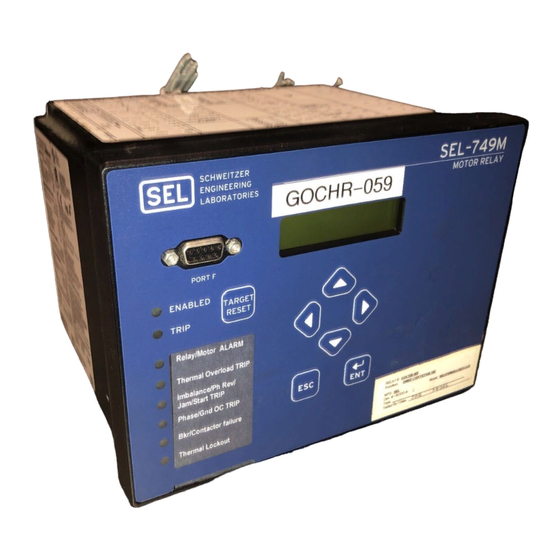
Schweitzer Engineering Laboratories SEL-749M Manuals
Manuals and User Guides for Schweitzer Engineering Laboratories SEL-749M. We have 1 Schweitzer Engineering Laboratories SEL-749M manual available for free PDF download: Instruction Manual
Schweitzer Engineering Laboratories SEL-749M Instruction Manual (314 pages)
Motor Protection Relay
Brand: Schweitzer Engineering Laboratories
|
Category: Relays
|
Size: 4 MB
Table of Contents
-
Preface15
-
Conventions16
-
Overview21
-
Features21
-
Applications24
-
Overview33
-
Overview53
-
Setup54
-
Terminal55
-
Settings57
-
Overview67
-
Logic Functions111
-
Overview119
-
Metering119
-
Overview127
-
Overview149
-
Overview177
-
Overview189
-
Event Reporting190
-
Overview203
-
Testing Tools203
-
Self-Test213
-
Troubleshooting215
-
Overview221
-
Overview235
-
Overview271
-
Devicenet Card271
-
Features272
-
Overview275
-
Overview287
-
Definitions288
-
Glossary295
-
Index301
Advertisement
Advertisement
Related Products
- Schweitzer Engineering Laboratories SEL-787
- Schweitzer Engineering Laboratories SEL-700G Series
- Schweitzer Engineering Laboratories SEL-700G1
- Schweitzer Engineering Laboratories SEL-700GT
- Schweitzer Engineering Laboratories SEL-787-2
- Schweitzer Engineering Laboratories SEL-787-2E
- Schweitzer Engineering Laboratories SEL-787-4X
- Schweitzer Engineering Laboratories SEL-787-3E
- Schweitzer Engineering Laboratories SEL-787-2X
- Schweitzer Engineering Laboratories SEL-787-4
